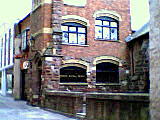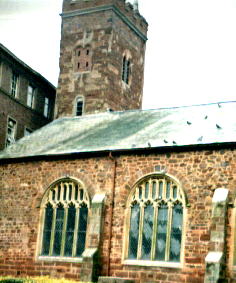
|

|
| Use the text links for more information! |
No sidebar menus?, Click Here and re-select |
| Catherine Street
Before heading up Martins Lane to the Ship,
nip along Catherine Street towards the flower beds.
On Your right you'll notice
Oddfellows Hall now incorporating Drake's Cafe and the Raw shoe shop. This building
has the date 1896 marked on it with Oxenham Lodge, but I would imagine that parts of it are much
older than that. Oddfellows Friendly Society first came to Exeter in 1845, their original premises
being the building now housing the Thirsty Camel in New North Road.
Further up Catherine St, opposite the ruins of St
Catherines Almshouses you'll notice an iron ring in the wall of the flower
bed. This marks the site of the Cathedral's old St Catherine's Gate. The
ring was once in the wall of the Country House Inn which used to stand to the
right of the ruins before 1942.
Before the Almshouses were founded in 1450, the gate was called Bickleigh or Berkly
or Ercevesk after Canon Reginals Ercevesk. This guy was was one the clergy
found guilty of consent to murder Walter Lechdale (mentioned below). The
Chapel incorporated with the Almshouses was built in 1458. King Alfred
was responsible for laying out a new street plan towards the end of the
9th century and St Catherine Street made up part of that plan. It was a
cunning plan but not that cunning.
The 1240's saw the Dominicans enclose
their house and church on the site of present day Bedford Street, but when the Cathedral
was walled, there was no access to the City Walls for the population of
Exeter. Edmund (Earl of Cornwall) decided in 1297 that the monks must share
the use of Freren Lane (now Chapel Lane - behind the small shops in Bedford
Street) with the mayor and Citizens of Exeter. Another gate was cut for
entry to this back lane. This entrance is seen today as St Stephens Bow
(between High Street and Catherine Street) ajoining St Stephens Church
and was cut in the very same 1297.
|

|
 |
Ruin
The ruins of St Catherines Almshouses and Annuellars College were left as a reminder of the blitz. The Church Army Hostel ran from St Catherines Almshouses from 1894. No man was ever refused shelter. Work aid was employed whereby food and shelter were given in return for work which entailed the collection of wood and the sawing of logs. To the right of the ruined almshouses are the remains of the Annuellars' College built in the C16th, these extended to Mol's in the Cathedral Close. The college was built on the site of a C14th house, the fireplace and oven of which are visible in the ruins. Before WW2, the college had been altered considerably and was the Countryhouse Inn. You may at this point want to nip into ExeShed, through the covered alleyway into Bedford Street. The bar is right in front of you. After your pint, retrace your steps. |
|
| St Stephens Church which is the other older building in the square opposite St Catherines ruins was registered in the Domesday survey of 1086, however an original crypt unearthed in the 19th century during repairs was probably from an original Saxon chapel. The church was used as a stable for a couple of years after 1658 when Cromwell decided the City should only have 4 City Churches. When the crown was restored so was St Stephens however a fire during the repair work totally destroyed the building which was re-built in 1664. | During the blitz of 1942 the surrounding area was flattened but the church remained intact except for the bells which fell to the ground and broke into pieces. These were remoulded into a new bell. The church is dedicated to the saint who was stoned to death for condemning the jews for the death of Jesus. He is the patron saint of Deacons. |
| Backtrack to St Martins Lane and just at the start of the lane on the first floor level of the SPCK bookshop you'll see the remains of an arch in the wall. This marks the site of the Cathedral's St Martin's Gate. Posts on either side of the lane mark the spot at ground level. The building itself has had many uses. It has been home for tradesmen, craftsmen and Priests and has also been the home of many businesses including a tailors, cobblers, barbers, an umberella maker and tobacconist. It has also been an antique shop and art gallery. |  |
|
Walter and the Gates In 1283 Walter Lechdale (Precentor at Exeter Cathedral) was murdered by intruders who entered the City by way of the South Gate. King Edward I attended the murder trial in late 1285 (he spent Christmas in Exeter with his wife Queen Eleanor and daughters Eleanor, Joan and Margaret). The trial of those accused took place under the framework of the King's Assembly, local nobility were summoned to lay down the law of the land. The legal side of the assembly was the 'Coram rege' (latin for 'in the King's presence'). This type of court rarely sat outside London after 1400 but does survive today as the King's / Queen's Bench. It was likely that the Royal Party stayed at Rougemont Castle close to the present day law courts in Exeter. |
| Four men were charged with the murder of Lechdale and several others including City officials were charged with aiding and abetting or similar charges. The Mayor was involved and so was the Vicar of Heavitree. After the trial the King consented to the Cathedral being walled to protect the Clergy and ecclesiastical buildings from urban Exeter. The walls were constructed from 1286 and made use of a considerable length of Roman Wall, elsewhere back doors were blocked off and existing walls extended. Seven gates gave access to the Cathedral Yard. These gates were St Catherine's, St Martin's, Broad Gate, Palace, Bear, Little Stile and St Petrocks Church. The Church was only a through-way when it's doors were open on both sides. The main gate was Broad Gate, which was several storeys high with a room to accomodate the gatekeeper. The gates catered for the traffic of the day and although it is no longer possible to see the gates themselves it is relatively easy to find their location. |
1825 saw the removal
of Broadgate and in 1826 it was decided that its site and the site of the
other six gates removed earlier should be marked. Stone posts with an iron
ring were erected. You have already visited the site of St Martin's and
St Catherine's Gate. Little Stile was close to where the Globe Inn used
to stand in the corner of Cathedral Yard. Broad Gate was opposite the Guildhall
entrance along High Street. Turn Left out of St Martins Lane. Broad Gate
is marked on the wall of the Halifax Building Society. St Petrocks is a
little further on.
The restaurant on the Cathedral Close / Broadgate corner was built when the gate was demolished. It has famously been known in the past as Tinleys. |
|
A ring can be seen in Bear Lane in the wall
which marks Bear Gate and the location of Palace Gate can be seen in Palace
Street by the street lamp outside the Bishops Palace Gatehouse. The palace
already had its own substantial stone gatehouse (still standing), but a
further wooden gatehouse was built to give wider access to the Close. The
wooden gatehouse was removed in 1812. St Petrocks, Broadgate, Bear Gate
and Palace Gate are incorporated into the City Centre (West) pub crawl.
Turn Left at the top of Martins Lane.
Even before the Lechdale murder there were countless disagreements between the City authorities and the Cathedral. Drinking water channeled through the underground passages was always disputed. |
No place to hide
Another was that fujitives from civic justice were able to get into the
Cathedral area very easily often with the help of the clergy. The City
official's law stopped at the boundary. The Close is still priviledged
to have it's own juristiction, the Bishop's fee or St Stephen's fee. The
burial ground in front of the Cathedral was consecrated which means that
it had and still has to be shielded from bad behaviour, especially the
odd punch up because any blood spilled would have put the cemetary out
of commision until the Bishop had held a ceremony to re-hallow the ground.
|
|
Drunken Drake
The Ship
Inn has had some very famous visitors in its time including Raleigh, Hawkins,
Grenville and Drake. Drake apparently wrote in a letter dated 1587, "next
to mine own shippe I do most love that old shippe in Exon, a tavern in
Fysh Street", as the street was then known to the people (St. Martin's
Lane to the Clergy)...."There yester'en I had some speach with a mariner
fresh come hither from Plymouth. The power of Spain is already afloat,
so in the morning please God, I am for Plymouth and for another shippe
than this". He had a quick game of bowls before giving the Spanish Armada
a bashing. Drake though could not hold his drink and was once kicked out out the Ship for being
drunk and disorderly.
During the Civil War
while Exeter was under siege from Genearl Fairfax, Cavaliar Captain Benet quartered his troops at the
Ship. In 1710 a mob also tried to burn it down as they thought some Whig-sponsored clegy were staying.
The Ship is shown on a map of 1876 as a long slender building stretching back from Martin's Lane. In 1910 an adjacent
building, the premises of a bookseller was taken over by the Ship making the the bar areas as large as they are today.
Neck your drink and head out. Turn right outside and you'll
come to the High Street at the end of the lane.
Stuart Callon Copyright ©2002
|
|